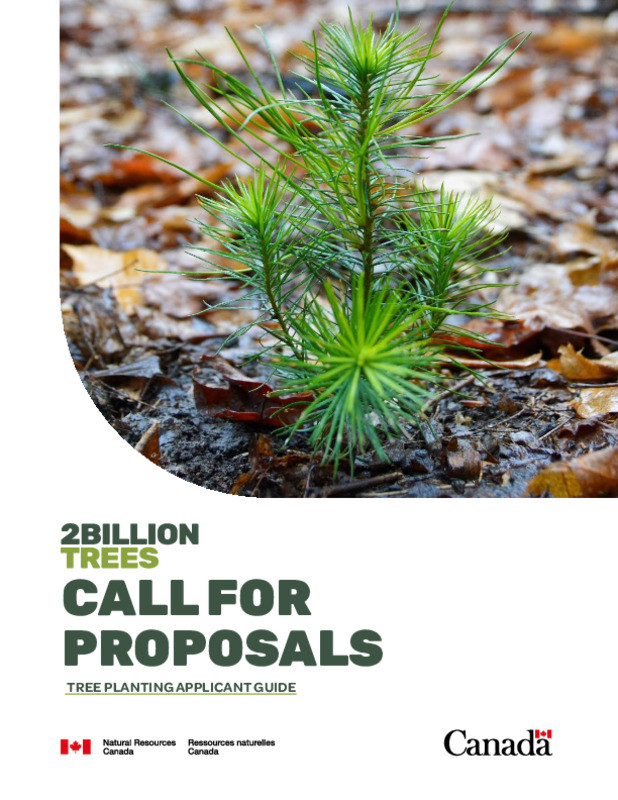Land Management Search Results
Resource
Authors
Mohiba Mollah
Dasvinder Kambo
This note is a short summary of an exciting new Canadian Forest Service (CFS) research project funded under the 2 Billion Trees (2BT) program. To optimize and monitor silvicultural practices following...
Resource
Authors
Mauhiba Mollah
Dasvinder Kambo
This note is a short summary of an exciting new Canadian Forest Service (CFS) research project funded under the 2 Billion Trees (2BT) program. The project entails the use of drone-based sensors and...
Resource
Authors
Mauhiba Mollah
Dasvinder Kambo
This note is a short summary of an exciting new Canadian Forest Service (CFS) research project funded under the 2 Billion Trees (2BT) program. This research project will use wood ash generated from...
Resource
Authors
Mauhiba Mollah
Dasvinder Kambo
This note is a short summary of an exciting new Canadian Forest Service (CFS) research project funded under the 2 Billion Trees (2BT) program. The project is a study to determine the feasibility of a...
Resource
Authors
Mauhiba Mollah
Dasvinder Kambo
This note is a short summary of an exciting new Canadian Forest Service (CFS) research project funded under the 2 Billion Trees (2BT) program. The project aims to measure and analyze growth and...
Resource
Authors
Mauhiba Mollah
Dasvinder Kambo
This note is a short summary of an exciting new Canadian Forest Service (CFS) research project funded under the 2 Billion Trees (2BT) program. The project will assess genomic data from urban and...
Resource
Authors
Mauhiba Mollah
Dasvinder Kambo
This note is a summary of an exciting new Canadian Forest Service (CFS) research project funded under the 2 Billion Trees (2BT) program. It involves enhancements to CFS’s national tree-ring database...
Resource
There is a lack of scientific knowledge on the growing conditions of black ash, a species of cultural importance to Indigenous communities, and its resilience to global changes. The objective of this...
Resource
Authors
Mauhiba Mollah
Dasvinder Kambo
This note is a short summary of a Canadian Forest Service (CFS) research project funded under the 2 Billion Trees (2BT) program. The project supports a key research objective of the program...
Resource
Authors
Mauhiba Mollah
Dasvinder Kambo
This note is a short summary of an exciting new Canadian Forest Service (CFS) research project funded under the 2 Billion Trees (2BT) program. The project aims to increase forest tolerance of climatic...
Resource
This research project will test different drone-based surveying methods to monitor tree survival and the carbon accumulated from planted trees. Both ground and drone surveys will be used in a number...
Resource
Authors
Erik Emilson
Isabelle Aubin
The 2 Billion Trees (2BT) program offers a unique opportunity to reduce net greenhouse gas (GHG) emissions while simultaneously ensuring co-benefits to water quality and aquatic ecosystem health. The...
Resource
The 2 Billion Trees (2BT) program aims to capture atmospheric carbon and reduce GHG emissions through the planting of 2 billion trees. A key topic researchers would like to explore is how Canada’s...
Resource
This research project will explore the relationship between changing climate, soil and site conditions, and site index (i.e., a metric to evaluate site productivity). The project team will produce...
Resource
This project aims to engage and build capacity with Indigenous communities to fulfill the multiple objectives of the 2 Billion Trees program. This project will build on established collaborations and...
Resource
Pathogens challenge early stages of forest regeneration and pose a risk to large-scale tree planting efforts such as the 2 Billion Trees program. Infected seedlings can show reduced performance and...
Resource
There is little known about the contribution of chemical traits to tree flammability. Even less is known about the potential genetic determinants of flammability. Improving our knowledge of these two...
Resource
This guide assists applicants with their submissions to the 2 Billion Trees program, specifically the 2BT Tree Planting Application form. It provides guidance on the information that will be requested...
Resource
This 2 Billion Trees (2BT) program research project will examine genetic families of western redcedar for resilience to climate extremes. It will also examine how drought impacts tree nutrient levels...
Resource
This research project aims to improve understanding of how remotely sensed recovery assessments can be used for the planning and monitoring of reforestation activities. The project will also explore...





